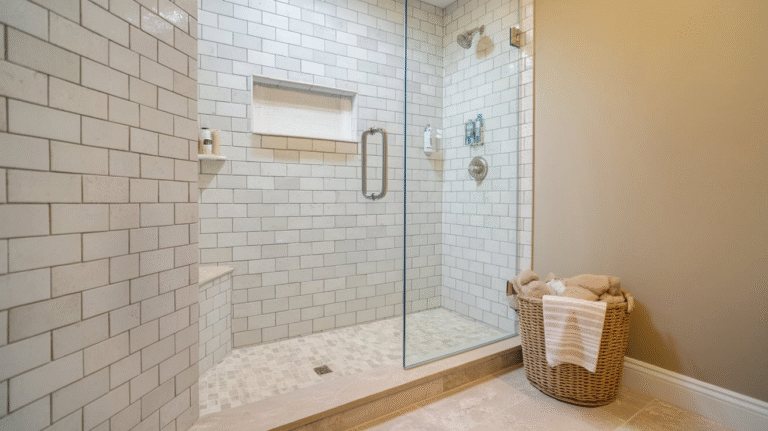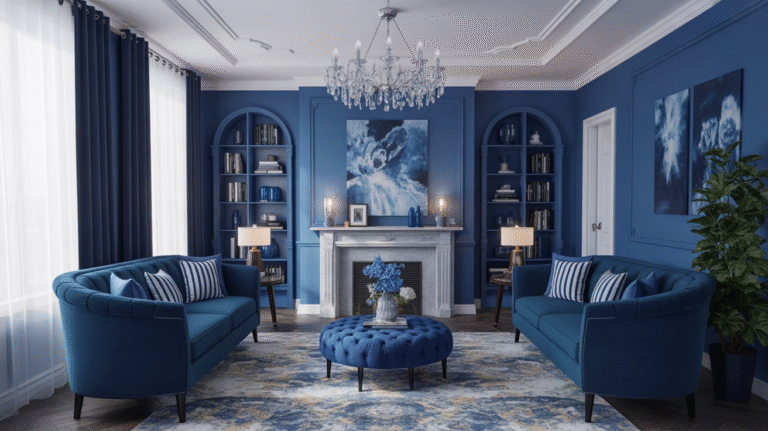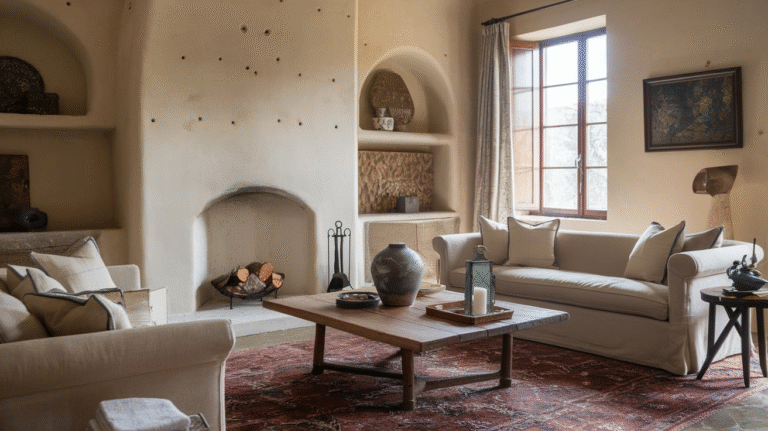20 Primitive Living Room Ideas
If you’ve ever walked into a space that felt instantly warm, rugged, and timeless—you’ve probably experienced the magic of primitive design.
This style doesn’t rely on sleek finishes or modern gadgets; instead, it embraces the beauty of simplicity, the honesty of raw materials, and the stories etched into every imperfection.
Primitive living rooms bring us back to our roots—literally. They remind us of a time when furniture was crafted by hand, when warmth came from a crackling fire, and when a home’s character wasn’t bought, but built over time.
Let’s explore 20 primitive living room ideas that will help you capture this authentic charm in your own home—without feeling outdated or overdone.
1. Celebrate Imperfection with Rustic Wood
Primitive design begins with real wood—the kind that tells stories through its knots, cracks, and uneven tones. Skip the polished veneers and opt for reclaimed barn wood or rough-hewn beams. These natural imperfections give your living room soul and texture.
Wooden coffee tables, sideboards, or ceiling beams make an instant impact. If you can, expose wooden ceiling rafters—they’ll add vertical warmth and a hint of history.
In a world obsessed with glossy perfection, the rough beauty of natural wood feels like a breath of fresh air—imperfectly perfect.
2. Use Earthy, Muted Tones
Primitive interiors thrive on earthy colors. Think shades of muddy brown, burnt umber, charcoal, ochre, and moss green. These colors echo the outdoors, bringing a grounded and serene energy to your living room.
Instead of stark white walls, go for warm neutrals like taupe, clay, or soft beige. According to interior design reports from Architectural Digest, earthy tones have surged in popularity since 2022, reflecting people’s growing desire for warmth and authenticity in their homes.
A pro tip: mix matte and textured finishes. A clay-colored plaster wall next to raw wood and aged leather creates depth without needing any flashy decor.
3. Opt for Handcrafted Furniture
One of the biggest secrets to achieving a true primitive living room is handmade furniture. Skip machine-made perfection and look for artisan-crafted pieces—the kind with slight variations that tell human stories.
A hand-carved coffee table, a rough oak rocking chair, or even a handwoven stool adds authenticity. Many modern homeowners are turning to local craftsmen or vintage markets for these finds.
Primitive design isn’t about mass production; it’s about meaningful possession. Every item should feel earned, not bought on impulse.
4. Expose Stone and Brick Walls
If you’ve got stone or brick walls hidden under plaster, now’s the time to let them shine. Exposed stone walls are a cornerstone of primitive charm—they add history, texture, and natural grounding.
If your home doesn’t have original stone, you can still achieve the look with faux stone panels or textured wallpaper that mimics the feel.
Pair with iron sconces or wrought-iron curtain rods to complement the rugged aesthetic. Even a single exposed wall can redefine the whole room’s mood—think of it as your home’s ancient heartbeat peeking through.
5. Layer with Vintage Textiles
Primitive living rooms thrive on texture. Bring in handwoven rugs, grain-sack pillows, wool throws, and cotton slipcovers. Look for faded colors and simple patterns like stripes, checks, or small florals.
Avoid synthetic materials—they clash with the organic vibe. Instead, go for natural fibers like jute, hemp, or wool.
A wool rug from a local weaver or a vintage quilt folded over your sofa adds warmth and character. It’s these details that make guests instantly feel at home.
6. Add an Old-Fashioned Hearth
A fireplace is the heart of any primitive living room. Whether it’s wood-burning or electric, it instantly becomes the room’s soul.
If you’re lucky enough to have a real stone hearth, emphasize it. Stack logs neatly nearby, hang an iron fire tool set, and add a weathered wood mantel.
Even if you don’t have a built-in fireplace, you can use a freestanding wood stove or decorative faux hearth to recreate the cozy effect.
According to the National Association of Home Builders, 76% of homeowners believe a fireplace increases both comfort and value—proof that timeless design never loses its spark.
7. Choose Distressed Finishes
Primitive style is not about shiny newness—it’s about age and patina. Furniture should look lived-in, not showroom-perfect.
Opt for distressed finishes: sanded edges, chipped paint, or oxidized metals. You can even DIY this look with a bit of chalk paint and light sanding.
The goal is to make your furniture look like it’s been passed down through generations—because, in a way, that’s what primitive style celebrates: continuity, tradition, and longevity.
8. Decorate with Found Objects
One of the joys of primitive design is collecting decor that feels authentic. Skip the mass-produced items and hunt for antique treasures—old milk jugs, wooden dough bowls, hand-forged tools, or weathered baskets.
Visit flea markets, estate sales, and thrift shops. You’ll often find pieces that carry decades of history for the price of a fast-food meal.
A primitive living room tells a story, and each object contributes a line to that story—no two spaces will ever look the same.
9. Incorporate Simple Window Treatments
Keep your windows bare or simply dressed. Heavy drapes or synthetic blinds clash with primitive aesthetics. Instead, go for linen or burlap curtains in natural shades.
If privacy isn’t a concern, leave windows uncovered to let natural light spill in. Sunlight bouncing off rustic textures creates a soft, golden glow that no artificial light can replicate.
As a finishing touch, consider iron curtain rods or wooden dowels instead of modern metallic finishes.
10. Light the Room Like the Old Days
Lighting in a primitive living room should mimic the soft warmth of candlelight. Think lanterns, sconces, candles, and lamps with fabric or parchment shades.
Avoid harsh overhead lighting. Instead, layer your light sources:
- A table lamp with a linen shade.
- Wall sconces for mood lighting.
- Candles for ambiance.
For authenticity, go for oil-lamp-style LED lights—they blend nostalgia with practicality. Warm, dimmable bulbs (around 2200K) create that old-world glow without actual flames.
11. Use Iron and Metal Accents
A touch of black wrought iron grounds the soft rustic textures and adds structure. You’ll see it used in vintage candle holders, hinges, latches, or light fixtures.
Iron complements natural wood and stone perfectly—it’s the strong, silent partner in the relationship.
You don’t need to overdo it; even small accents like a metal wall sconce or forged coffee table legs can make the entire room feel authentic.
12. Add Primitive Wall Art
When it comes to wall decor, less is more. Primitive wall art often features folk motifs, nature scenes, or antique silhouettes.
Handmade signs with inspirational quotes, stitched samplers, or aged portraits bring subtle visual interest without overpowering the room.
Look for pieces with muted tones and weathered frames—they blend beautifully with rustic textures.
13. Incorporate Functional Storage Pieces
In primitive homes, storage wasn’t decorative—it was practical. But that doesn’t mean it can’t look good.
Use wooden chests, antique cupboards, and woven baskets for both storage and decor. A large wooden trunk can serve as a coffee table while storing blankets or board games.
This approach keeps your space clutter-free and authentic. As they say, “Function first—but make it beautiful.”
14. Bring in Nature
A primitive living room thrives on a connection with the outdoors. Incorporate dried flowers, branches, pinecones, or potted plants for a subtle, organic touch.
Arrange a few wildflowers in a clay vase or place driftwood on your mantel—it’s about quiet beauty, not perfection.
Research shows that biophilic design (decorating with natural elements) can improve mood and reduce stress by up to 20%, according to studies from the University of Exeter. Nature truly nurtures.
15. Mix Lighting Textures and Warmth
Layering texture isn’t just about materials—it’s also about how light interacts with them. A stone wall under soft light feels completely different than under cool, direct lighting.
Mix ambient light with accent lighting to create depth. For example, a lantern casting shadows across a rough wall instantly adds dimension and warmth.
Every primitive room deserves a touch of mystery and glow, like a campfire on a quiet night.
16. Choose a Primitive-Inspired Sofa
Your sofa is likely the largest piece in the room—so let it speak the language of comfort and craftsmanship.
Look for sturdy wooden frames, neutral upholstery, and simple lines. Avoid overly modern shapes or shiny materials.
A linen slipcovered sofa or distressed leather couch fits beautifully. Pair it with handmade pillows and a chunky knit throw for cozy authenticity.
Remember: comfort is king in primitive design. A sofa should look like it’s been there for generations and will stay for generations more.
17. Add Layered Rugs
Primitive design loves layered rugs—they add warmth, texture, and visual storytelling. Combine flat-woven jute rugs with hand-knotted wool runners for dimension.
Patterns should stay subtle: think faded plaids, stripes, or natural fiber weaves. The more weathered, the better.
If your floors are hardwood, the contrast between smooth and textured will add richness to your space. It’s like layering stories beneath your feet.
18. Incorporate Antiques and Heirlooms
Nothing says “primitive charm” like furniture with history. Add antique dressers, rocking chairs, or tables that carry visible signs of age.
Even a single heirloom—like your grandmother’s lamp or your uncle’s handmade shelf—can serve as an anchor point for the entire design.
If you don’t have heirlooms, antique stores and local auctions are treasure troves for authentic finds. The key is to choose pieces that feel lived in, not perfect.
19. Keep Technology Subtle
One of the biggest challenges of primitive design in modern homes is managing technology. Televisions, cords, and smart devices can easily disrupt the old-world atmosphere.
Mount your TV on a wood-paneled wall or hide it inside a cabinet. Use woven baskets to store remotes or chargers discreetly.
Opt for low-profile speakers or devices with wood finishes to help them blend in. The goal is to let your living room feel timeless—even if it’s secretly tech-savvy.
20. Tell a Story Through Simplicity
At its heart, a primitive living room is about storytelling. Every nick on a table, every uneven brushstroke, every faded fabric speaks of time and use.
Instead of filling the room with decor, focus on meaningful minimalism—a few well-loved objects that reflect who you are.
When someone walks into your living room, they should sense your personality and your connection to history. Primitive design isn’t just a style—it’s a philosophy: the belief that beauty lies in simplicity, honesty, and imperfection.
Conclusion
Designing a primitive living room is like rediscovering an old melody—you might have forgotten how much it resonates until you hear it again. It’s a return to warmth, authenticity, and craft.
Each of these 20 primitive living room ideas offers a way to create a space that feels grounded yet welcoming. From distressed wood furniture and handmade textiles to earthy tones and soft candlelight, the goal is to create a sanctuary that feels timeless.
Primitive style isn’t about following trends; it’s about celebrating life’s imperfections—and finding beauty in them. So whether you start small with a rustic lamp or go all-in with reclaimed wood walls, remember this: your home should feel like it’s been loved for years, even if it’s brand new.
Because at the end of the day, that’s what primitive design is all about—living simply, beautifully, and authentically.



